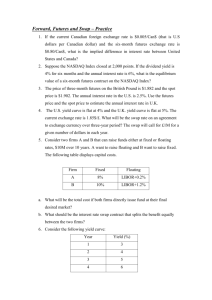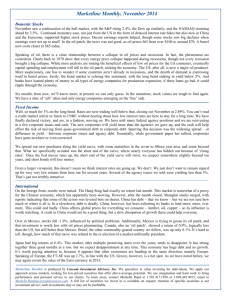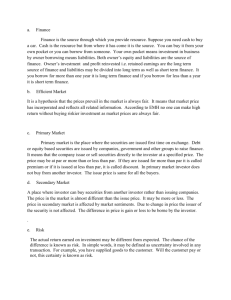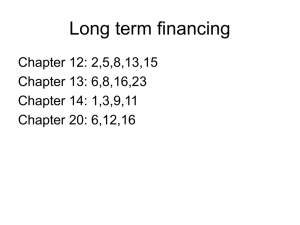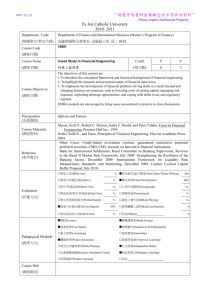Evolution of the Fixed Income Market September 10, 2004
advertisement
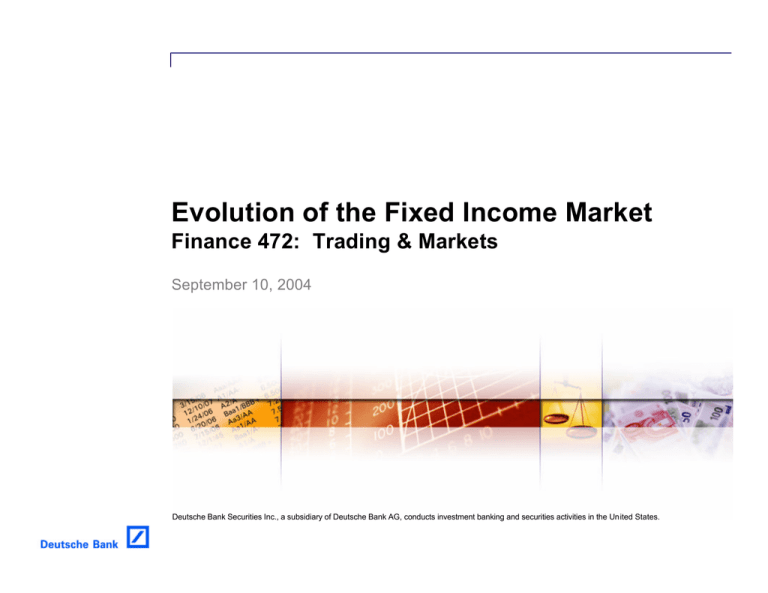
Evolution of the Fixed Income Market Finance 472: Trading & Markets September 10, 2004 Deutsche Bank Securities Inc., a subsidiary of Deutsche Bank AG, conducts investment banking and securities activities in the United States. Contents Section 1 Unsecured Debt and Swap Market 2 Development of Mortgage and Asset Backed Securities 3 Issuer Case Study: Capital One 2 Unsecured Debt and Swap Market Section 1 “Neither a borrower, nor a lender be. . . ” --Polonius, to his son Laertes, in Hamlet 4 What is Debt Capital Markets? The bankers within DCM focus principally on the Liabilities component of the balance sheet. While definitions can vary by firm, at DB all of the corporate-facing debt originators and risk marketers are within DCM n Envision the corporate balance sheet. Specialist bankers are responsible for covering each component of a corporate balance sheet. In addition to delivering their own specialties, these bankers also work together to deliver multi-disciplinary solutions that encompass more than one section of the balance sheet. Assets M&A and corporate finance bankers = Liabilities + Shareholders’ Equity Debt originators and derivative marketers Equity capital markets and corporate finance bankers n The debt originators are responsible for underwriting transactions with their client base in a broad range of currencies: USD, EUR, GBP, JPY and AUD, as well as smaller ones. n The risk marketers -- all highly specialized -- focus separately on interest rate, currency, commodity and credit risk 5 Key Players in the Origination, Sales and Trading of Corporate Debt The Capital Markets process of matching investors with issuers requires intricate coordination between various parts of an investment bank Cash bond traders Credit Trading Credit Research Credit default swap traders Debt originators Issuers DCM Syndicate Sales Investors Derivative marketers Interest rate swap traders Interest Rate Trading Treasury traders 6 Treasury Yield Curve Normal Curve 6% 5% Flat Curve 4% Yield Yield Curve Curve as as of of 9/7/04 9/7/04 33 month month 66 month month 11 year year 22 year year 33 year year 55 year year 10 10 year year 30 year 30 year 3% Inverted Curve 2% 1% 1.62% 1.62% 1.88% 1.88% 2.11% 2.11% 2.56% 2.56% 2.89% 2.89% 3.46% 3.46% 4.24% 4.24% 5.01% 5.01% Steep Curve 0% 1yr 5yr 10yr 15yr 20yr 25yr 30yr 7 Treasury Yield Curve Last 20 years Interest rates have fallen dramatically over the last 20 years The principal reason for this secular decline in rates has been a precipitous decline in inflation In recent years a decline to new low in rates has been driven by the 2001-2002 recession and accommodating Fed monetary policy US Treasury Yield Curve 14% Inverted yield curve 12% Flat yield curve 10% Steep yield curve 8% 6% 4% 2% 0% 1984 1986 1988 1990 1992 1994 1996 1998 2yr 2000 5yr 2002 10yr 2004 30yr 8 Credit Spreads Relative to Treasuries High-quality corporate bonds are quoted as basis point spreads to Treasuries. The basis point spreads equate to incremental yield for the greater credit risk of a corporate bond versus a Treasury bond 10% 9% 8% Capital One Fin.: Baa3/BB+ ( +130) 7% 6% 5% Georgia Pacific: Ba1/BB+ ( +158) Ford: A3/BBB- ( +199) Boeing: A3/A ( +65) Capital One Fin.: Baa3/BB+ ( +85) 2% Dow Chemical: A3/A- ( +126) GlaxoSmithKline: Aa2/AA ( +69) Comcast: Baa3/BBB ( +95) 3% 1% GM: Baa1/BBB ( +229) Xerox: Ba2/BB- ( +233) 4% Corporate credit spreads are theoretically driven by the probability of default (failure by the borrower to pay principal or interest) and the anticipated recovery of principal (as a % of par) if there is a default AT&T: Ba1/BB+ ( +281) GECC: Aaa/AAA ( +52) GECC: Aaa/AAA ( +34) Disney: Baa1/BBB+ ( +45) Comcast: Baa3/BBB ( +42) 0% 1yr 5yr 10yr 30yr 9 Corporate Credit Spreads Closer Look Corporate Yield = Treasury Yield + Corporate Spread (bps) = Treasury Yield + (Amortization of implicit premium generated by writing puts on the equity of the specific company) n Corporate bond investor accepts risks that equity cushion (SE = Assets minus Liabilities) will decline or even become negative (leading to an event of default) n Equity volatility (both company-specific and in index form, as expressed by the VIX) influences corporate spreads as well. Low volatility translates into low implicit option premium and tight corporate spreads. Conversely, high volatility leads to high premium and wide spreads. n Capital structure arbitrageurs look to profit from discrepancies in valuation of different layers of a given company’s capital structure. 10 Historical Credit Spreads Periods of low volatility are typically accompanied by small spread increments for differing levels of credit risk Stock market bubble bursts, economy goes recession, frequency Historical into Credit Spreadsdefault Over 10yr Treasuries accelerates 2.5% 2.0% Periods of high volatility typically see much greater spread increments for the same differences in risk 1.5% Spread Decompression US economy begins to recover; assets reflate Russian debt default/LTCM Spread Compression Asian crisis 1.0% 0.5% 0.0% 1991 1992 1993 1994 1995 1996 1997 1998 1999 2000 2001 AA 2002 A 2003 2004 BBB 11 Historical Issuance Volume Historical US Investment Grade and High Yield Issuance Issuance volume has multiplied as funding cost became cheaper 800 14% 700 12% 600 10% 8% 400 6% Inv. Grade (LHS) 300 High Yield (LHS) 200 4% 10y Treasury Note (RHS) 2004 YTD 2003 2002 2001 2000 1999 1998 1997 1996 1995 1994 1993 1992 1991 1990 1989 1988 0% 1987 - 1985 2% 1984 100 1986 $ Billions 500 Rates Issuance Volume 12 Historical Default Rates Global Corporate Bond Default Counts & Dollar Volumes, 1982-2003 $160 180 $140 Volume (US$ Billions) After prolonged periods of economic growth, lax underwriting standards and/or investor avarice can exacerbate the pressures of economic weakness 200 $120 Volume (US$ Billions) (LHS) Default Count (RHS) Oops! Corporate bonds actually do carry principal risk! 160 140 120 $100 100 $80 80 $60 Default Counts Recessions lead to sharp increases in default frequencies $180 60 $40 40 $20 20 $0 0 1982 1983 1984 1985 1986 1987 1988 1989 1990 1991 1992 1993 1994 1995 1996 1997 1998 1999 2000 2001 2002 2003 Source: Moody’s Investor Services 13 Historical Default Migration Average One-Year Ratings Transition Matrix: 1920-2002 Default frequencies for B and Caa-Ca illustrate the term “junk bond” In bond market parlance, an NCAA champion is a bond that defaults before the first semi-annual coupon is paid – “no coupon at all” Ratings From Default migration studies measure how badly and how quickly credit can deteriorate Aaa Aa A Baa Ba B Caa-C Aaa 88.37% 1.17% 0.07% 0.04% 0.01% 0.00% 0.00% Aa 6.31% 86.99% 2.36% 0.25% 0.08% 0.04% 0.02% A 0.96% 5.75% 86.09% 3.92% 0.42% 0.14% 0.03% Ratings To: Baa Ba 0.20% 0.01% 0.63% 0.15% 4.78% 0.62% 82.66% 4.72% 4.76% 78.41% 0.56% 5.86% 0.32% 1.21% B 0.00% 0.02% 0.10% 0.65% 5.38% 75.99% 4.59% Caa-C Default 0.00% 0.00% 0.00% 0.07% 0.02% 0.12% 0.09% 0.29% 0.50% 1.11% 3.22% 3.67% 71.72% 13.27% WR 4.15% 5.21% 5.82% 7.38% 9.33% 10.52% 8.84% Average Cumulative Credit Loss Rates from 1 – 5 years (1982 – 2003) 1yr 2yr 3yr 4yr Aaa Aa 0.00% 0.03% 0.08% A 0.01% 0.05% 0.14% 0.24% Baa 0.15% 0.40% 0.69% 1.13% Ba 0.88% 2.50% 4.49% 6.56% B 4.19% 9.75% 15.12% 20.37% Caa-Ca 17.14% 30.91% 44.84% 55.91% 5yr 0.03% 0.14% 0.34% 1.55% 8.59% 25.27% 66.80% Source: Moody’s Investor Services 14 Corporate Debt Issuance—Sellers (“Issuers”) Autos 1% TMT 5% Other 2% Consumer/Retail 3% Examples Energy/Power 13% Healthcare 5% Financial 63% Industrial 8% Financials Domestic Bank 25% Foreign Bank 9% Specialty Finance 9% Insurance 10% Captive Finance 12% Broker/Dealer 22% REIT 13% Auto (Captive Finance) Ford Motor Co. General Motors American Honda Telecom/Media/Technology AT&T Motorola IBM Consumer/Retail Anheuser-Busch Wal-Mart Procter & Gamble Financials Citigroup Washington Mutual Bank Allstate Industrial General Electric Caterpillar John Deere Healthcare GlaxoSmithKline Pfizer Energy/Power Con Edison of New York Pacific Gas and Electric Other FedEx Berkshire Hathaway Sovereign/Supranationals Republic of Philippines International Finance Corp. 15 Sample Buyers of Corporate Debt n Asset Managers: Blackrock, PIMCO, WAMCO, etc. n Banks: Bank of New York, Citibank, HSBC, etc. n Corporates: Caterpillar Investment Management, Fannie Mae, Microsoft, etc. n Hedge funds: BlueBay, SAC Capital, Solent, etc. n Insurance Companies: Aegon, AIG, Northwestern Mutual Life, etc. n Mutual Funds: Dreyfus, Fidelity, Vanguard, etc. n Pension Funds: General Electric Pension Fund, Teachers Insurance & Annuity Assoc., etc. n Retail (“mom-and-pop”): Muriel Finkelstein in Boca Raton, FL, plus hundreds of thousands of others. n State Fund: Alabama State Fund, California PERS, Maryland State Retirement and Pension System, etc. 16 Evolution of the European Corporate Credit Market Historical European Investment Grade and High Yield Issuance Arrival of Monetary Union created a single-currency eurodenominated credit market to rival the US market 600 AAA/AA 500 400 A/BBB High Yield “Belgian dentist” buys individual bonds from highly-rated, highly recognized companies like Siemens, BT, GE, and Ford 300 200 100 2004 YTD 2003 2002 2001 2000 1999 1998 1997 1995 1994 1993 1992 1991 1990 1989 1988 1987 1986 1985 - 1984 $ Billions The “institutionalization” of European money management has turned credit into an asset class 700 1996 Recent issuance growth among European A/BBB rated entities have outpaced AAA/AA rated issuers Year 17 Largest Debt Transactions in History The largest capitalraising initiatives ever have occurred in the unsecured debt market Rank 1 2 3 4 5 6 7 8 9 10 Date June 2003 March 2001 June 2000 May 2001 March 2002 November 2001 December 2000 October 2001 January 2001 July 1999 Issuer General Motors/GMAC France Telecom Deutsche Telecom WorldCom General Electric Capital Corp. (GECC) AT&T British Telecom Ford/Ford Motor Credit Ford Motor Credit Ford/Ford Motor Credit Size $17.5 Bn $16.4 Bn $14.6 Bn $11.9 Bn $11.0 Bn $10.1 Bn $10.0 Bn $9.4 Bn $9.3 Bn $8.6 Bn Currencies US$, Euro, GBP US$, Euro, GBP US$, Euro, GBP, JPY US$, Euro, GBP US$ US$, Euro US$ US$, Euro US$, Euro US$ Deals in bold indicate Deutsche Bank served as Bookrunner 18 Innovations in US Corporate Bond Market n Early ‘80s Ø Swaps to create funding efficiencies and foster cross-currency funding opportunities n Early/mid ’80s Ø Deep and liquid high-yield market (“junk bonds”) n Late ’80s Ø Puttable bonds n 1993 Ø 100-year bonds (“Century Bonds”) n 1993 Ø Tax-deductible preferred stock (equity credit at a debt cost) n Continuous Ø Issuance in new currencies (e.g., CZK, DKK, HUF, NOK, SGD, ZAR) n 1995 Ø Retail investor-targeted debt ($25 par baby bonds, MTNs) n 1996-1997 Ø Synthetic put bonds (derivatives market-enhanced optionality for issuers) n 1997 Ø Inflation-linked debt n 1997 Ø GIC-backed notes n Late ’90s Ø Evolution of European credit market n 2000 Ø Extendible notes (expand 2a7 money fund capacity at status quo backstop bank facility capacity) n Early ’00s Ø Credit default swaps as a risk management tool 19 Interest Rate Swaps n An interest rate swap is an agreement between two counterparties to exchange a set of cashflows over an agreed time period in the future. 5yr Interest Rate Swap Diagram LIBOR, reset semiannually Client 5yr Swap Rate = 3.92% n An interest rate swap is essentially a PV-weighted average of expected future LIBOR rates. Intuition Behind Pricing Illustrative Cashflow LIBOR Forwards vs. Swap Rate 5.50% Fixed Leg 5.00% Beg of End of period Period 9/9/04 3/9/05 3/9/05 9/9/05 9/9/05 3/9/06 3/9/06 9/11/06 9/11/06 3/9/07 3/9/07 9/10/07 9/10/07 3/10/08 3/10/08 9/9/08 9/9/08 3/9/09 3/9/09 9/9/09 4.50% 4.00% 3.50% 3.00% 5yr Swap Rate = 3.92% 2.50% LIBOR Fwd Curve 2.00% 1.50% 1.00% 3/05 9/05 3/06 9/06 3/07 9/07 3/08 9/08 3/09 9/09 Discount Factor Coupon 0.9896 3.92% 0.9761 3.92% 0.9605 3.92% 0.9429 3.92% 0.9246 3.92% 0.9047 3.92% 0.8845 3.92% 0.8637 3.92% 0.8428 3.92% 0.8214 3.92% NPV Floating Leg PV Pmt 1.94 1.91 1.88 1.85 1.81 1.77 1.73 1.69 1.65 1.61 17.86 LIBOR 2.08% 2.72% 3.22% 3.63% 3.98% 4.28% 4.51% 4.74% 4.93% 5.11% NPV PV Pmt 1.04 1.36 1.56 1.77 1.83 1.99 2.02 2.08 2.09 2.14 17.86 20 Interest Rate Swaps: Who Uses and Why? Pay Floating; Receive Fixed Banks Agencies/ Mortgage Hedge funds Corporates Fund managers Receive Floating; Pay Fixed Match assets with liabilities; Leverage balance sheet Match assets with liabilities Convexity hedging / Manage prepayment risk Convexity hedging / Manage average life extension risk Relative value / Yield enhancement / Yield curve riding / leverage asset base Relative value / Yield enhancement Hedging interest rate exposure (mostly converting fixed debt to floating) Hedge anticipated fixed-rate issuance or swap floating-rate bank debt to fixed Relative value / Yield enhancement Relative value / Yield enhancement 21 Floating Interest Rates – Forward Curve In a steep yield curve environment, such as the current one, forward rates suggest a rapid near-term rise in rates Many market participants will elect to “bet” against this by overweighting fixed-rate assets or floating-rate liabilities, or both. 3m LIBOR Forwards 6.00% 5.00% Current Current 3mL 3mL (9/7/04) (9/7/04) 4.00% Current Current Swap Swap Rates Rates (9/7/04) (9/7/04) 3.00% 1-Year 1-Year 2-Year 2-Year 3-Year 3-Year 4-Year 4-Year 5-Year 5-Year 2.00% 1.00% Sep '04 Mar '05 Sep '05 Mar '06 Sep '06 2.42% 2.42% 2.95% 2.95% 2.34% 2.34% 3.66% 3.66% 3.92% 3.92% Mar '07 Sep '07 Forward Forward LIBORs LIBORs Sept ’04 Sept ’04 Dec Dec ’04 ’04 Mar Mar ’05 ’05 Jun ’05 Jun ’05 Dec Dec ’05 ’05 Dec ’06 Dec ’06 Dec Dec ’07 ’07 Mar '08 Sep '08 Mar '09 1.86% 1.86% 1.86% 1.86% (+0bps) (+0bps) 2.29% 2.29% (+43bps) (+43bps) 2.59% 2.59% (+73bps) (+73bps) 2.86% (+100bps) 2.86% (+100bps) 3.27% 3.27% (+141bps) (+141bps) 3.99% (+213bps) 3.99% (+213bps) 4.51% 4.51% (+265bps) (+265bps) Sep '09 22 Overprediction of LIBOR Forward Curves The “hair chart” illustrates that forward curves have nearly systematically overpredicted the eventual path of LIBOR 11.00% 10.00% 9.00% 8.00% 7.00% 6.00% 5.00% 4.00% 3.00% Actual LIBOR Historical LIBOR forward curves 2.00% Current LIBOR forward curve 1.00% 1989 1991 1993 1995 1997 1999 2001 2003 2005 2007 2009 23 Cross-Currency Swaps Euro/USD Cross-Currency Swap n A cross-currency swap can be used to convert interest and principal denominated in one currency into another currency (e.g., from the foreign currency into a company’s functional, or local, currency) Euro Fixed Client US$ Fixed Components of a Euro/USD Cross Currency Swap Euro Fixed A cross-currency swap, in essence is an aggregate of multiple swap positions n Euro Fixed/Floating Swap: The Euro LIBOR leg is eventually crossed out by the Euro LIBOR leg from the Basis swap Client Euro LIBOR Euro LIBOR n n Basis swap: Adjusts floating-rates across different currencies: in this example between US$ LIBOR and Euro LIBOR USD Fixed/Floating Swap: The US$ LIBOR leg crosses out the US$ LIBOR leg from the Basis swap Client US$ LIBOR + Spread US$ LIBOR + Spread Client US$ Fixed 24 Cross-Currency Issuance Case Study: SLM Corporation (A2/A) in Australian Dollars Fixed-Rate Notes Student lender SLM Corp. used crosscurrency swaps to capture a window in the “kangaroo” market to raise A$600m swapped back into US$ ($438.3m) at a cost savings versus US issuance while generating substantial investor diversification Floating-Rate Notes Announcement Date: May 5, 2004 Announcement Date: May 5, 2004 Maturity Date: May 18, 2009 Maturity Date: May 18, 2009 Size: A$375mm Size: A$225mm Launch Spread: Mid Swaps + 40 bps Launch Spread: Bank Bills + 40 bps Bookrunners: Deutsche Bank, UBS Bookrunners: Deutsche Bank, UBS Co-Managers: CBA, Citigroup, NAB, RBC Co-Managers: CBA, Citigroup, NAB, RBC Transaction Highlights and Motivation n This transaction represents SLM’s inaugural offering in the Australian market, and at a total size of A$600mm, this was the largest single-A kangaroo bond ever issued in the Australian market n With total annual unsecured debt issuance needs of $10+ billion, SLM looks to maximize investor diversification by issuing in multiple currencies and regions. Investor diversification leads to increased demand for SLM’s paper and ultimately more attractive debt pricing n As such, Deutsche Bank recommended an Australian transaction, providing SLM with access to a completely new investor base. Being a new issuer in the Australian market, SLM was able to achieve attractive pricing as investors looked to include a new US credit in their portfolios n As the US Dollar is SLM’s functional currency, the entire deal was swapped to US$. The attractive basis swap between A$ and US$ allowed SLM to meet its funding targets n This transaction met SLM’s goals of investor diversification and issuance at levels slightly better than US$ levels (2 to 3 bps) n With such a successful transaction, SLM has positioned itself well to be a regular and well-received issuer in the domestic Aussie market Evolution of the Interest Rate and Currency Swap Market Historical Interest Rate and Currency Swap Notionals 160 140 120 100 $ Trillions 80 60 40 20 2003 2002 2001 2000 1999 1998 1997 1996 1995 1994 1993 1992 1991 1990 1989 1988 - 1987 The near exponential growth of the swap market has been driven by a broader awareness of and comfort with this technology’s ability to mitigate risk, transform cash flows and generate returns Year Source: International Swap and Derivatives Association 26 Development of Mortgage and Asset Backed Securities Section 2 Development of the Mortgage Backed Securities Market Size of the Mortgage Backed Securities (“MBS”) Market § Total Size of U.S. Mortgage Market: $7.5 Trillion Non-Agency CMO's 13% § Roughly $4.0 Trillion in MBS outstanding § $3.5 Trillion in Agency MBS outstanding Agency MBS 62% § $2.5 Trillion in Agency MBS $1.5 Trillion FNMA § $0.6 Trillion FHLMC § $0.4 Trillion GNMA § $1.0 Trillion in Agency CMOs § $0.5 Trillion FHLMC § $0.4 Trillion FNMA § $0.1 Trillion GNMA § Agency CMO's 25% § Roughly $0.5 Trillion in Non-Agency CMOs Source: Bond Market Association Statistics (March 31, 2004), Deutsche Bank Securities 28 Mortgage-Backed Securities Securitization: Turning Loans into Securities Birth of Mortgage-Backed Securities 8% 30 Year Mortgage Obligation, with house pledged as collateral BANK Borrows Money INDIVIDUAL HOMEOWNER $100,000 29 Mortgage-Backed Securities (continued) Mortgages Swapped to become Mortgage-Backed Securities With possession of FNMA instead of Mortgages, Bank can: 1. Sell FNMA into liquid __market 2. Borrow against it __efficiently 3. Keep it on balance __sheet with less __capital $1 million 7.5% FNMA Certificate backed by ‘Full Faith and Credit’ of U.S. Government 8% 30 Year Mortgage Obligation, with house pledged as collateral BANK Borrows Money INDIVIDUAL HOMEOWNER $100,000 Bank swaps a pool of ten $100,000 8% interest rate mortgages Pays insurance premium 0.25% Continues to receive Servicing Fee 0.25% FNMA (“Federal National Mortgage Association”) 30 Typical Bank Balance Sheet Assets Liabilities Senior More Liquid FNMA Certificates Deposits Single-Family Mortgages Term Notes Student Loans Less Liquid Auto Loans Credit Card Loans Preferred Stock Equity Subordinated 31 Collateralized Mortgage Obligations § CMO’s allowed cash flows of 30 year mortgages to be cut up and tailored to suit investor preferences. Tranching of Cash Flows FNMA 7.5% CASH FLOW (12 YEAR AVERAGE LIFE, 30 YEAR AMORTIZATION) Investment Horizon: Short Term Intermediate Term Intermediate/Long Term Long Term Average Life: 2 years 5 years 10 years 20 years Amortization Window: 4 years 4 years 8 years 14 years Investor Type: Banks Banks/Insurance Insurance Insurance/Pension Funds 32 Impact of CMO’s on Mortgage Costs 30 Year Mortgage Benchmark vs. 30 Year Treasury Benchmark 20% 18% Advent of Early CMO's 16% 14% 12% 10% 8% 6% 4% 2% 0% 1980 1981 1982 1983 1984 1985 1986 1987 1988 1989 1990 1991 1992 1993 1994 1995 1996 1997 1998 1999 2000 2001 2002 2003 2004 Spread to 30 Year Treasury Benchmark Average Spread Before CMO's: 286 bps 30 Year Mortgage Benchmark 30 Year Treasury Benchmark Average Spread After CMO's: 134 bps Source: Freddie Mac & Bloomberg 33 ABS Market Overview § Wall Street starts to turn its attention to securitization of other asset categories: – 1985: Auto Loans, 1987: Credit Cards, 1988: Home Equity Loans, 1993: Student Loans ABS Market Continues Growth Trajectory billions $763.8 $750 $700 $650 $600 $550 $500 $450 $400 $350 $300 $250 $200 $150 $1.2 $100 $50 $0.2 $1.0 $0 85 $161.6 $581.3 $128.5 $434.7 $313.9 $343.9 $91.9 $465.4 $271.2 $273.9 $167.0 $113.5 $10.0 $24.4 $43.4 $52.1 $55.9 $63.1 $81.8 $19.5 $9.1 $14.9 $3.2 $2.2 $11.0 $8.0 $5.2 $2.7 $22.6 $12.9 $2.8 $10.3 $21.9 $17.1 $6.7 $6.9 $17.4 $24.9 $8.3 $9.4 $19.6 $25.8 $19.5 $11.1 $32.1 $19.1 $16.1 $2.7 $6.4 $2.2 $6.9 $5.8 $0.2 $9.8 86 87 88 89 90 91 92 93 94 Automobile Credit Card $109.3 $100.7 $70.7 $188.9 $109.1 $103.0 $69.5 $42.5 $38.7 $310.2 $96.6 $219.0 $77.2 $87.5 $73.8 $57.6 $68.4 $70.2 $64.9 $54.4 $47.4 $49.4 $41.0 $42.8 $41.4 $49.6 $69.8 $77.7 $82.4 $37.8 $40.2 $83.6 $36.4 $75.9 $30.5 95 96 97 98 99 00 01 02 03 04* Home Equity Other * Data annualized. Source: Deutsche Bank, Thomson Financial Securities Data 34 ABS Market Overview (continued) Estimated Outstandings of U.S. Fixed Income Securities – $22.8 Trillion Asset Backed, $1.8 trillion, 7.8% Mortgage Related, $5.4 trillion, 23.5% Municipal, $2.0 trillion, 8.6% Money Market, $2.6 trillion, 11.6% Corporate, $4.6 trillion, 20.0% Fed Agencies, $2.8 trillion, 12.1% As of Q2 2004 US Treasury, $3.8 trillion, 16.5% Source: Bond Market Association 35 The Forces Driving Asset Securitization Issuer Incentives – Capital efficiency – Funding diversification – Asset-liability management – Accounting gain on sale – Manage portfolio growth Investor Incentives – Attractive nominal yield and better credit relative to corporates for similar ratings – Generally low payment variability relative to MBS – Excellent liquidity in most sectors 36 Some Top Clients 37 League Tables: Total ABS Market 2003 2004 Year to Date (2) (Excluding Self-Funded Issues & Shelf Issues) (Excluding Self-Funded Issues & Shelf Issues) Lead Manager 1 Citigroup Principal (mm) (1) Market Share (%) $45,555.2 11.8 Lead Manager 1 Citigroup Principal (mm) (1) Market Share (%) $32,328.0 12.5 2 Deutsche Bank Securities 40,502.0 10.5 2 Deutsche Bank Securities 25,211.0 9.7 3 JP Morgan 36,735.2 9.5 3 JPMorgan 23,385.7 9.0 4 Credit Suisse First Boston 34,849.9 9.1 4 Greenwich Capital 21,724.4 8.4 5 Banc of America Securities 30,473.5 7.9 5 Credit Suisse First Boston 21,191.1 8.2 6 Morgan Stanley 29,261.3 7.6 6 Merrill Lynch 21,109.3 8.2 7 Lehman Brothers 25,878.6 6.7 7 Banc of America Securities 17,967.2 6.9 8 Greenwich Capital 25,160.0 6.5 8 Lehman Brothers 16,750.9 6.5 9 Merrill Lynch 20,865.0 5.4 9 Morgan Stanley 15,575.9 6.0 5.0 10 10 Bear Stearns 19,314.2 UBS 14,746.7 5.7 Total of top 10 Managers $308,594.9 80.2% Total of top 10 Managers $209,990.2 81.1% Industry Total $384,944.3 100.0% Industry Total $258,987.8 100.0% Source: Thomson Financial Securities Data (SDC) and Deutsche Bank Securities 1) In U.S. dollar equivalents based on exchange rate as of pricing date. 2) As of July, 2004 38 Case Study: Capital One § As the ABS Market has grown to rival corporate market, an increasing number of major corporations have used securitization as a principal means of financing their business: Capital One: Alternative Funding On-Balance Sheet Funding Assets Off-Balance Sheet Securitization Funding – Liability Structure Credit Cards Liabilities Sub-Prime Autos Prime Autos Autos 81.25% Credit Cards 92.0% Corporate Debt 8.0% Equity 97.55% AAA 2.45% A 87.0% AAA 13.0% O/C (L+11) BBB (L+70) 10.0% International AAA 7.25% 1.5% A (L+36) BBB (L+83) O/C AAA-BBB avg = L+ 70 bps vs. AAA-BBB avg = L+ 19 bps 39 History of ABS – An Issuer’s Perspective Steve Linehan, SVP & Treasurer, Capital One Financial Corporation 41 Capital One is: A major credit card player A diversified consumer financial services company 34th largest depository institution in the U.S. A significant capital markets issuer • 5th Largest Visa/Mastercard issuer • $45.3 managed U.S. credit card assets • • • • 2003: $1.1B net income, ROA 1.52%, ROE 23.4% $71.8 B in managed loans 37% of assets are outside of U.S. Card 18% of Q1 2004 profits are non U.S. Card • $23.6B in deposits • Direct Retail Deposits • Brokered Deposits • Over $20.2B of Capital Markets issuance in 2003 • ABS programs include U.S. credit card, non-prime and prime auto, U.K. credit card • Unsecured programs include senior and subordinate debt • Ratings: BB+/BBB- Baa3/Baa2 42 Capital One continues to deliver strong earnings Earnings Per Share $5.60 $5.90 1 $6.00 $4.85 $5.00 $3.93 $4.00 $2.91 $3.00 $2.24 $1.72 $2.00 $1.32 $1.00 $0.48 $0.64 $0.77 1994 1995 1996 $0.93 $0.00 Growth Rate 33% 21% 1997 21% 1998 42% 1999 30% 2000 30% 2001 30% 2002 35% 23% 2003 15-22% One of three companies to earn > 20% EPS growth for 10 consecutive years 1) As of July 21, 2004. 43 2004E Capital One’s Killer App: The Information Based Strategy- IBS World Class People & Analytics Massive Innovation Scientific Laboratory Microsegmentation/ Mass Customization One of the Largest Databases in the World Quantum Advance in Risk Management 44 We are using IBS to diversify our assets Diversified Managed Outstandings 100% 13% 90% Auto ($9.4B) 80% 25% 70% GFS ($18.7B) 60% 50% 40% 62% 30% 20% 10% 0% 1997 1998 1999 2000 2001 45 2002 2003 Q204 Card ($45.2B) Funding Mix – Securitization is important to Capital One Total Managed Liabilities and Capital 100% 8% 5% Capital Other Liabilities* 27% Deposits 9% Senior Notes Auto Securitizations 80% 60% 8% 40% 43% 20% 0% 1998 1999 2000 2001 2002 2003 Q2 2004 * Includes repos, Fed Funds, trust preferred46securities, various payables and other liabilities Off-Balance Sheet Securitizations The Rationale for Securitization • Allows lower-rated companies to fund at approximately AA levels • The higher ratings on issuer’s securitization “debt” vs. its unsecured debt broadens its investor base and enhances its liquidity • Transactions may represent risk transfer and qualify as sales Funding Cost Funding, Diversification, & Liquidity Accounting & Regulatory Capital Requirements – – Asset Liability Management • Issuers don’t need to hold capital against securitized assets for regulatory capital requirements Issuers don’t need to reserve against loan losses on securitized assets Securitization transactions are an effective tool for asset liability management, including maturity, currency, and basis (fixed vs. floating) management 47 Securitization enables us to access deeper investor bases at lower costs HIGH AVAILABILITY COST MOST COMMERCIAL BANKS AND FINANCE COMPANIES COB COFC LOW AAA AA A BBB BB B C D Securitization benefit increases during times of market disruptions 48 Credit Card securitization involves the issuance of securities secured by a designated pool of asset receivables “sold” to a bankruptcy remote entity Capital One Bank (originator of assets) Receivables on Accounts Capital One Master Trust Proceeds from ABS Issuance 49 Asset Backed Securities Investors The financial engineering of cash flows creates credit rating efficiency To achieve investment-grade ratings, credit enhancement is needed to protect investors from changes in loss performance. Capital One Subordination Structure Senior As unsecured revolving debt obligations, credit card receivables offer limited recovery in the event of cardholder default. Class A 81.25% (“AAA”) Credit enhancement is provided through: Subordination (Class B and C tranches) – Excess spread is the net income of a securitization trust that flows back to the issuer. Spread or reserve accounts • A mechanism to capture excess spread if performance begins to deteriorate. Excess spread is function of: Trust revenue Gross portfolio yield Trust expenses Investor coupon Servicing fee Charge offs Trust net income Excess spread Class B 10% (“A”) Class C 7.25% (“BBB”) Class D 1.50% (“BB”) 20.00% Excess Spread -5.00% -2.00% -6.00% Spread Account 7.00% 50 Credit Enhancement – Interest and principal payments are made to subordinate tranches only after all senior payments have been made. Subordination • Subordinate – Credit Card ABS have bullet maturities just like corporate unsecured bonds making them attractive to a broad investor base Investment: Credit card ABS, three-year bullet maturity Bond cash flow $10,000,000 investment 10,000,000 8,000,000 Interest paid to investor 6,000,000 Principal paid to investor 4,000,000 2,000,000 0 1 2 3 4 5 6 7 8 9 10 1 1 12 13 1 4 15 16 1 7 18 19 20 21 22 23 24 25 26 27 28 29 3 0 31 32 3 3 34 35 3 6 Accumulation period Revolving period Collateral balance ($) Collateral: Credit card accounts, monthly principal and interest receipts Excess seller interest Required seller interest Investor interest 6 12 18 Revolving period 24 30 36 Accumulation period 51 Funding costs are lower and less volatile than the company’s corporate debt Indicative 5 Year Fixed Rate Cost of Funds for Capital One 12.0% 11.0% 10.0% High 6.13% 11.29% 5.95% Deposits Corporate Debt Card ABS 9.0% Low Average 3.60% 4.72% 3.78% 6.66% 3.13% 4.37% Std Dev 0.60% 1.92% 0.76% 8.0% 7.0% 6.0% Corporate Debt 5.0% Deposits CARD ABS* 4.0% 3.0% 2.0% 1.0% Jun-04 May-04 Apr-04 Mar-04 Feb-04 Jan-04 Dec-03 Nov-03 Oct-03 Sep-03 Aug-03 Jul-03 Jun-03 May-03 Apr-03 Mar-03 Feb-03 Jan-03 Dec-02 Nov-02 Oct-02 Sep-02 Aug-02 Jul-02 Jun-02 *ABS represents the weighted avg. cost of funds for 5 year COMET deal including A, B and C tranches 52 Securitization is an effective capital management tool % of Capital Required 12% Illustrative Example ROE 25% 10% 20% 8% 15% 6% 10% 4% 5% 2% 0% 0% With Securitization Without Securitization 53 Securitization markets provide flexibility to meet our asset-liability management objectives Deterministic Net Interest Income Sensitivity Percent Change in 12-Month NII 6% % Change in 12 Month NII 4% 2% Limit 0% 7/31/04 NII rises 1.4% or $78MM Limit -2% -4% -6% Down 300 Rate Shock Down 200 Down 100 Basecase Up 100 Up 200 Programs • • • • Fixed Rate 3, 5, 7 years • Floating Rate 3, 5, 7 ,10, 15 years £ Denominated transactions using • US Collateral € Denomintaed transactions using US Collateral £ denominated transactions using £ collateral € denominated transactions using £ collateral $34B swap book also used to manage interest rate & currency risk 54 Up 300 Capital One continues to enjoy success in the capital markets U.S. Card Securitizations Triple-A Single-A Triple-B U.K. Card Securitizations (1) Auto Loan Securitizations Prime Non-Prime Senior Notes Subordinated Notes Total 2003 1H 2004 $5,100 $1,100 $1,375 $981 $3,100 $650 $668 $1,249 $2,000 $2,125 $2,000 $500 $20,271 $850 $1,000 $1,000 $10,279 1) In U.S. dollar equivalents based on exchange rate as of pricing date 55 Capital One expects to remain a lead issuer in the securitization market US Cards US Autos 2003 Issuer 2004 YTD Total $ (billions) (%) Issuer 2003 Total $ (billions) (%) Issuer 2004 YTD Total $ (billions) (%) Issuer Total $ (billions) (%) 1 Citibank 14.1 21.7 1 Bank One 5.7 18.8 1 GMAC 10.4 13.4 1 GMAC 4.6 9.0 2 Bank One 10.4 16.1 2 MBNA 5.2 17.2 2 Honda 6.1 7.8 2 Ford 4.6 9.0 3 MBNA 9.1 14.0 3 Capital One 4.6 15.1 3 Nissan 5.9 7.6 3 WFS 4.1 8.0 4 Capital One 6.9 10.7 4 Citibank 4.4 14.4 4 WFS 4.8 6.2 4 Daimler Chrysler 4.1 8.0 5 Chase 6.5 10.0 5 Chase 3.4 11.1 5 Ford 4.7 6.0 5 Honda 3.5 7.0 6 Discover 3.6 5.5 6 American Express 3.4 11.0 6 Daimler Chrysler 4.3 5.5 6 USAA 3.0 6.0 7 American Express 3.1 4.8 7 Providian 1.5 4.8 7 Chase 3.6 4.6 7 Nissan 2.5 5.0 8 Gracechurch 3.0 4.6 8 GE 1.0 3.3 8 Capital One 3.5 4.5 8 Capital One 2.5 5.0 9 Household 2.3 3.5 9 Gracechurch 0.8 2.6 9 Americredit 3.3 4.3 9 AmeriCredit 2.0 4.0 Advanta 1.5 2.3 10 World Financial Network 0.5 1.7 10 Toyota 2.9 3.7 10 Chase 1.5 3.0 64.9 100.0 30.5 100.0 77.7 100.0 50.8 100.0 10 Industry Total Industry Total Industry Total Source: Deutsche Bank Securitization Monthly As of July 31, 2004 #3 ABS Issuer in 2003 #1 ABS issuer YTD 2004 56 Industry Total
